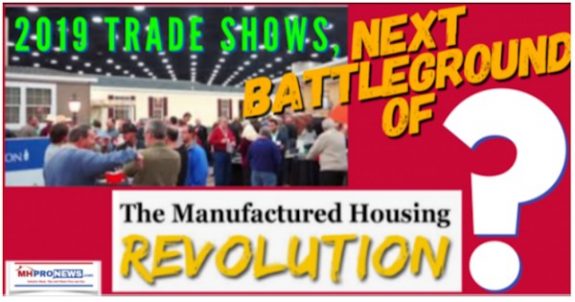
Capital, other market manipulations, plus an apparent failure by the Arlington, VA based Monopolistic Housing Institute (MHI) to deliver on their self-proclaimed ‘promotion’ of the industry are obvious takeaways from the latest new HUD Code manufactured home (MH) shipment report. But those are not the only problems that the Manufactured Home (MH) industry and its numerous varied professionals face. Yet, every problem – properly understood – is an opportunity in disguise.
Cohesion – so called ‘unity’ – sounds like a noble goal. But for various reasons that aren’t the focus of this column, cohesion won’t possibly be achieved accept by conquest of the larger powers, OR until clear alternatives to the present Omaha-Knoxville-Arlington axis power structure in MHVille are established.
Without balanced and mutually respected interests, how else could cohesion or unity be achieved?
The aim of alternative structures in MHVille should not be to create a new monopolistic nexus that challenges the current monopolistic one.
Rather, the goal should be to fuel in an authentic manner what made manufactured housing a far greater – in sheer size and scope – the industry in the past to begin with. Diversity! Thousands of MH Independents, and hundreds of different independent producers. There was diversity galore in those MH Industry glory days gone by. That’s how growth is proven to occur.
Genuine vs. Weaponized Insights
To be historically more accurate about manufactured housing, what too many industry pros never lived through – and thus never understood – is that the old Fleetwood and the old Champion home builders each established their own unique vertically integrated machines in the 1990s. Those firms are not the Fleetwood or Champion of today, but the names are similar.
The old Fleetwood and the old Champion had a similar thirst for market domination as Warren Buffett, Berkshire Hathaway, Kevin Clayton and Tim Williams at 21st Mortgage jointly share. The ongoing relevance of the Manufactured Housing Association for Regulatory Reform (MHARR) has long been as a counterweight to the Machiavellian Housing Institute, err, Manufactured Housing Institute, then or now.
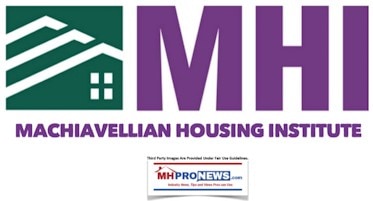
The names at the top of the pile at MHI have changed, but the challenges have has some similarities.
Monopolistic practices that manipulate capital access, political, placement, and regulatory schemes are the enemy. What MHARR, or National Federation of Independent Business (NFIB) have done for decades for smaller firms is provide the authentic cover that MHI has arguably long neglected.

The Omaha-Knoxville-Arlington axis is simply better at building moats than Fleetwood and Champion were. By ‘better,’ one should understand ‘cheaper.’
For example, the old Fleetwood and Champion arguably overpaid in many cases for the retail centers they acquired. By contrast, the evidence in the linked reports reflect that Buffett’s style of moat-building underpays for businesses. They accomplish that by artificially depressing sales and thus business and/or property valuations.
That process thereby creates the “value” acquisition Buffett and his longtime partner Charlie Munger crave. The rest are details and commentary.
Manufactured Home Production Decline Accelerates in November 2018
It is Buffett who reportedly said he wants sharks in the waters of his Moat, not MHProNews. We simply accept that – plus the evidence of his, Kevin Clayton, and Tim Williams – each at their own words. Perhaps one reason why – until this point in time – that their respective attorneys rattle sabers in our direction instead of just sue, is that they know that it is hard to argue with their own words.

Which leads us to trade shows and the opportunity for the next phase of the Manufactured Housing Revolution.
New Era in National U.S. Manufactured Home Community Representation Underway?
Show Ways Unlimited and Manufactured Housing Trade Shows
Sources with close ties to Show Ways Unlimited are among those that shed light on how Clayton allegedly manipulated the now defunct Carolina show, and tipped it out of existence. Those same informed sources have said that Clayton only entered the Louisville Show as a defensive mechanism, to counter the independents who were behind the revival of the show. Team Clayton has been working to undermine the Tunica Show, per sources, by establishing their own show in Birmingham, AL. Those claims are whatever they are, and should be discerned in the light of the evidence.
Meanwhile, the current trade shows are nothing like the glory days of Louisville or the Nashville Show, which was the forerunner of the Tunica Show. Back in the glory days, 100, 150, or 200 plus new homes used to crowd exhibit halls and parking lots. Professionals from around the world attended those much larger events. The mainstream media came too, just as they do today for automotive, RV, and boat shows.
One question that potential MH Revolutionaries must ask is this. Is this going to be an industry on the rise or slide? Do you want to enhance the income-producing and exit-value of your business, or do you want to sell it someday cheap to a monopolistic player?
One must look at authentic manufactured housing history, not the weaponized version that some like George F. (F?) Allen produces, that later version of which magically places Allen himself in the center of the MH Universe.
Allen, like MHI, is arguably a would be power-broker. If he and his MHI supported allies can succeed at diminishing the largest trade publisher in the industry – MHProNews – that would make Allen appear to be bigger than he is. It’s somewhat like taking a lake and shrinking it, to make little fish look bigger. Sad.
What MHI and Allen have in common are meetings that draw a crowd, however modest. Never mind that those crowds are small compared to a manufactured housing trade show. For those who would shrink an industry in order to grow their own influence, it is arguably a bit like Buffett’s moats. Only G F (F?) Allen’s is discernably cruder in execution.
A key to authentically re-growing the industry has long been about more than attracting more industry professionals to an event. As or more important, one must also attract mainstream media, new potential lenders (as Triad has done for years), and investors. Then, post-industry trade days, there must also be public days. It worked in the past, why not now? It’s worked for RVs, and other industries, why not ours in MHVille?
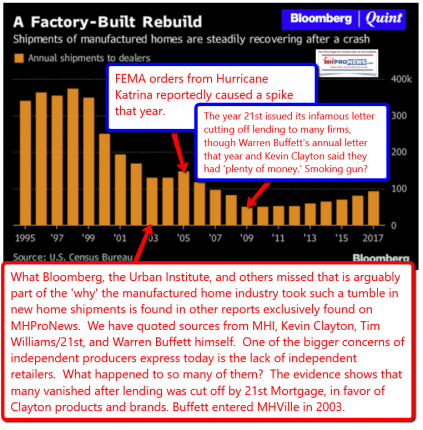
Among the most common comments heard at Louisville and Tunica every year from exhibitors is, why aren’t there public days? The same old tired story is given in reply by show management, year after year. Who does that old, tired cover-story benefit?
This writer had an operation that used what amounted to ‘public days’ to sell dozens of additional homes per year to retail customers. Few things would serve to remove the stigma of the industry better than spotlighting realty, instead of allowing the old ‘mobile home’ or ‘trailer house’ stereotypes to live on.
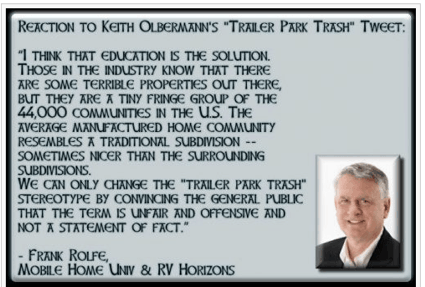
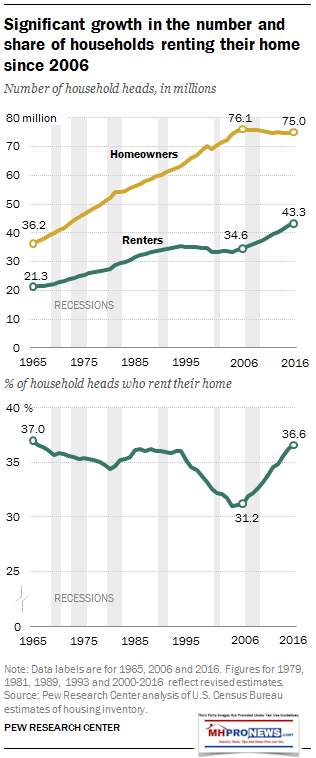
There is an obvious opportunity to start that ball rolling at the upcoming 2019 trade shows. That is where hundreds of independent retailers and communities will be. But those must be an organizing stepping stone to something that is entirely new in 2020.
That there is frustration in MHVille is apparent to all who will listen.
The launch of a new community association is but one example. The longtime existence of MHARR as a counterweight to MHI is another. A third is the #NobleNotMobile concept. Like MHI member Frank Rolfe’s lament against MHI and what he called their hypocrisy, Paul Bradley and ROC USA are MHI members too. Bradley was clearly no longer satisfied with what MHI claims as promotion. Thus Bradley and his colleagues conceived of #NobleNotMobile, and that’s how frustration gave birth to action.
There are 22 million Americans living in pre-HUD Code mobile homes, and post-HUD Code manufactured homes. There are millions more in the U.S. who rent. According to Pew Research, CityLab and others, about 100 million in the U.S. are living in rentals. Most of those obviously fail to seriously consider manufactured housing as an option, in part, due to the ‘trailer’ stigma.
Ten percent of either of those 2 populations groups could swing many elections in the nation. Something similar could occur in Canada, for that matter.
The ability of the industry to achieve it full potential lies not along the proven failed path of the Manipulative Housing Institute, and the arguably hypocritical and jealous path of yesterday’s news, George F (F?) Allen.
The path is to forge new structures that fuel independents. That must avoid the problems that made MHI the Menacing Housing Institute that it has become.
The humble observations, evidence, allegations, history, and logic herein are for the industry’s and investors consideration.
Among the next questions should be this one. At what point will the bulk of the industry’s remaining independents realize that their numbers are still shrinking? They are shrinking in the community and retail sides.
The number of retailers and communities are shrinking during an affordable housing crisis. Is that coincidence or market manipulation? Who’s side is MHI on? In that battle, who’s side has George F. (F?) Allen taken?
The new HUD Code manufactured home shipment tallies are going to be low and vulnerable to many headwinds so long as the number of distribution points, producers, capital access, and image all remain artificially limited. That’s what producers – including MHI members – tell us.
The fact that the Omaha-Knoxville-Arlington Axis would apparently stoop to using a surrogate like George F (F?) Allen, speaks volumes. It’s the latest in a series of over-the-target reactions, previously reported. See the linked report, further below.
Taking Charge of Your Own Future by Teaming with Others Like Yourself
The time to take the bull by the horns is now. Hundreds of billions in new capital is flowing into the U.S. Jeff Bezos led Amazon’s Alexa Fund estimates that the market potential is $330 billion annually.
You do the math that mathematically-challenged MHI can’t or won’t do for you. They claimed, incorrectly (again), the Manufactured Housing adds $3 billion a year to the economy. At retail in 2017, the obvious math was some $6.5 billion.
Divide $6.5 billion into $330 billion.
The product of the above is how much the potential growth could be for factory-homebuilders of all kinds.
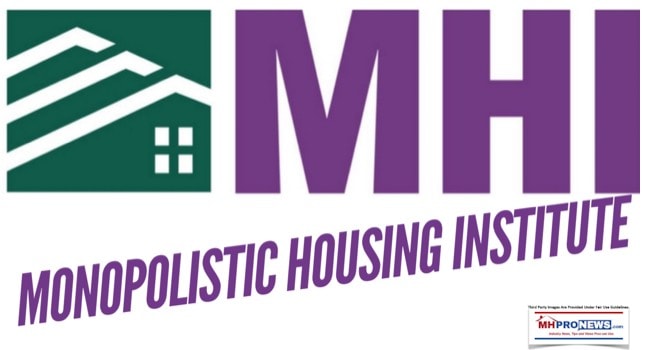
New paths, new structures to do for retailers, communities, and all others in the industry are how that potential is to be tapped. That’s the next step in the Manufactured Housing Revolution. Ready to take that next step? Ready to take a step that will liberate you from the Omaha-Knoxville-Arlington Axis? “We Provide, You Decide.” © ## (News, commentary, and analysis.)
(See Related Reports, further below. Text/image boxes often are hot-linked to other reports that can be access by clicking on them. Third-party images and content are provided under fair use guidelines.)
By L.A. “Tony” Kovach – for MHProNews.com.
Tony is the multiple award-winning managing member of LifeStyle Factory Homes, LLC, the parent company to MHProNews, and MHLivingNews.com.
Office 863-213-4090 |Connect on LinkedIn:
http://www.linkedin.com/in/latonykovach
Click here to sign up in 5 seconds for the manufactured home industry’s leading – and still growing – emailed headline news updates.
Related References:
The text/image boxes below are linked to other reports, which an be accessed by clicking on them.
Bridging Gap$, Affordable Housing Solution Yields Higher Pay, More Wealth, But Corrupt, Rigged Billionaire’s Moat is Barrier – manufacturedhomelivingnews.com
America woke up today to division. But perhaps 75 percent (+/-) of the nation’s people could come together on a plan that demonstrably could do the following. Increase the U.S. Gross Domestic Product (GDP) by some $2 Trillion Annually, without new federal spending.

